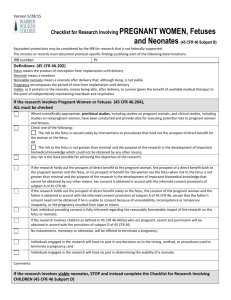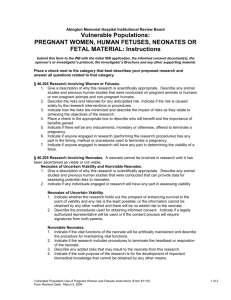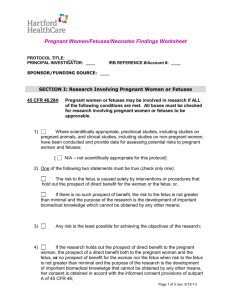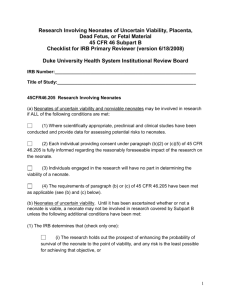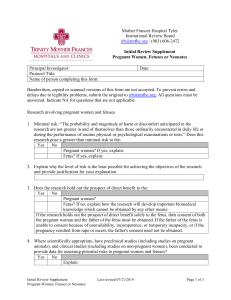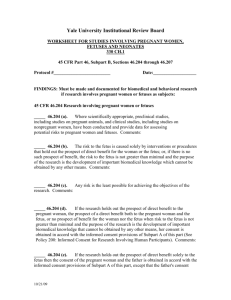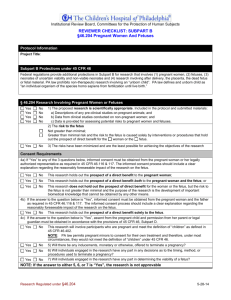Pregnant Women, Fetuses, Neonates
advertisement
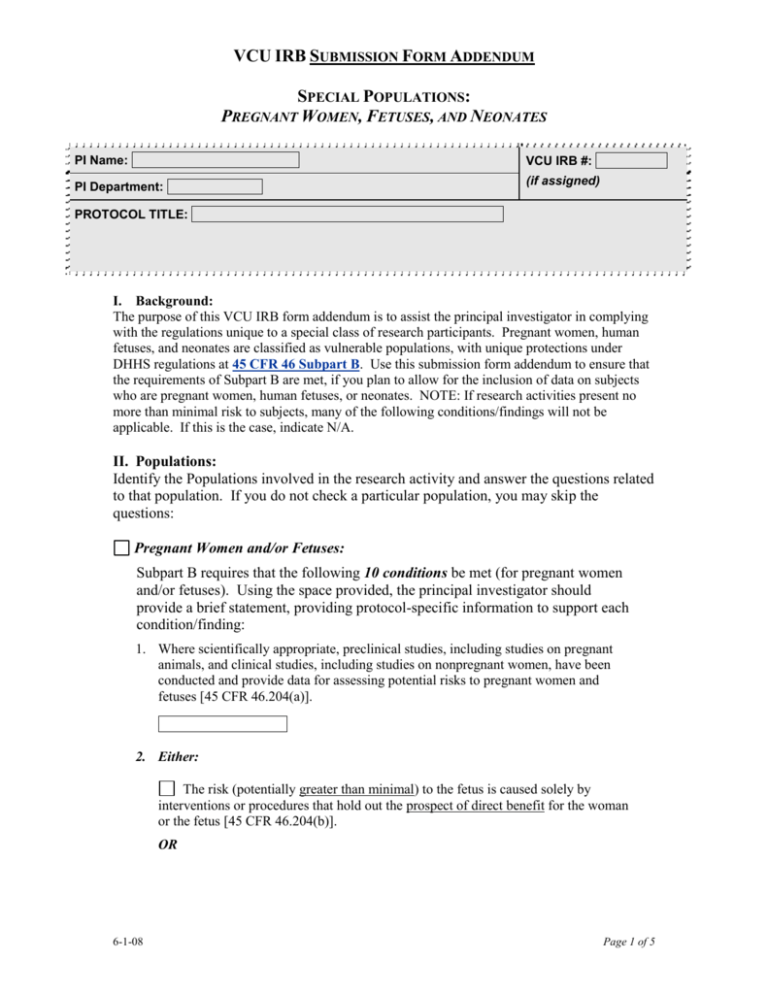
VCU IRB SUBMISSION FORM ADDENDUM SPECIAL POPULATIONS: PREGNANT WOMEN, FETUSES, AND NEONATES PI Name: VCU IRB #: PI Department: (if assigned) PROTOCOL TITLE: I. Background: The purpose of this VCU IRB form addendum is to assist the principal investigator in complying with the regulations unique to a special class of research participants. Pregnant women, human fetuses, and neonates are classified as vulnerable populations, with unique protections under DHHS regulations at 45 CFR 46 Subpart B. Use this submission form addendum to ensure that the requirements of Subpart B are met, if you plan to allow for the inclusion of data on subjects who are pregnant women, human fetuses, or neonates. NOTE: If research activities present no more than minimal risk to subjects, many of the following conditions/findings will not be applicable. If this is the case, indicate N/A. II. Populations: Identify the Populations involved in the research activity and answer the questions related to that population. If you do not check a particular population, you may skip the questions: Pregnant Women and/or Fetuses: Subpart B requires that the following 10 conditions be met (for pregnant women and/or fetuses). Using the space provided, the principal investigator should provide a brief statement, providing protocol-specific information to support each condition/finding: 1. Where scientifically appropriate, preclinical studies, including studies on pregnant animals, and clinical studies, including studies on nonpregnant women, have been conducted and provide data for assessing potential risks to pregnant women and fetuses [45 CFR 46.204(a)]. 2. Either: The risk (potentially greater than minimal) to the fetus is caused solely by interventions or procedures that hold out the prospect of direct benefit for the woman or the fetus [45 CFR 46.204(b)]. OR 6-1-08 Page 1 of 5 The risk to the fetus is not greater than minimal and the purpose of the research is the development of important biomedical knowledge which cannot be obtained by any other means [45 CFR 46.204(b)]. 3. Any risk is the least possible for achieving the objectives of the research [45 CFR 46.204(c)]. 4. If the research holds out the prospect of direct benefit to the pregnant woman, the prospect of a direct benefit both to the pregnant woman and the fetus, or no prospect of benefit for the woman nor the fetus when risk to the fetus is not greater than minimal and the purpose of the research is the development of important biomedical knowledge that cannot be obtained by any other means, her consent is obtained in accord with the informed consent provisions of subpart A of this part [45 CFR 46.204(d)]. 5. If the research holds out the prospect of direct benefit solely to the fetus then the consent of the pregnant woman and the father is obtained in accord with the informed consent provisions of subpart A of this part, except that the father's consent need not be obtained if he is unable to consent because of unavailability, incompetence, or temporary incapacity or the pregnancy resulted from rape or incest [45 CFR 46.204(e)]. 6. Each individual providing consent under paragraph (4) or (5) above is fully informed regarding the reasonably foreseeable impact of the research on the fetus or neonate [45 CFR 46.204(f)]. 7. For children as defined in Sec. 46.402(a) who are pregnant, assent and permission are obtained in accord with the provisions of subpart D of 45 CFR 46 [45 CFR 46.204(g)]. 8. No inducements, monetary or otherwise, will be offered to terminate a pregnancy [45 CFR 46.204(h)]. 9. Individuals engaged in the research will have no part in any decisions as to the timing, method, or procedures used to terminate a pregnancy [45 CFR 46.204(i)]. 10. Individuals engaged in the research will have no part in determining the viability of a neonate [45 CFR 46.204(j)]. 6-1-08 Page 2 of 5 Viable Neonate: Subpart B specifies that if research data is collected on a neonate (newborn, after delivery) that is VIABLE, the regulations for special protections for children apply (Subpart D). Please note that if research data is collected on the pregnant women, or the viability of the neonate is questioned, other sections of this document apply. Non-Viable Neonate: Subpart B specifies that if research data is collected on a neonate (newborn, after delivery) that is NON-VIABLE, the following 4 conditions be met. NOTE: the 4th condition is a series of unique requirements. The principal investigator should provide a brief statement, providing protocol-specific information to support each condition/finding: 1. Where scientifically appropriate, preclinical and clinical studies have been conducted and provide data for assessing potential risks to neonates [45 CFR 46.205(a)(1)]. 2. Each individual providing consent under this section is fully informed regarding the reasonably foreseeable impact of the research on the neonate [45 CFR 46.205(a)(2). 3. Individuals engaged in the research will have no part in determining the viability of a neonate [45 CFR 46.205(a)(3)]. 4. The additional requirements unique to non-viable neonates, below, have been met [45 CFR 46.205(a)(4)]. Additional Requirements for Including Data on Non-Viable Neonates: 4(1). Vital functions of the neonate will not be artificially maintained. [45 CFR 46.205(c)(1)]. 4(2). The research will not terminate the heartbeat or respiration of the neonate [45 CFR 46.205(c)(2)]. 4(3). There will be no added risk to the neonate resulting from the research [45 CFR 46.205(c)(3)]. 6-1-08 Page 3 of 5 4(4). The purpose of the research is the development of important biomedical knowledge that cannot be obtained by other means [45 CFR 46.205(c)(4)]. 4(5). Legally effective informed consent must be obtained from both parents. Waiver or alteration of elements of informed consent is not allowed. Legally Authorized Representatives are not permitted. One parent may consent only when the other parent is unable to consent due to unavailability, incompetence, or temporary incapacity. If the pregnancy resulted from rape or incest, the father need not consent. [45 CFR 46.205(c)]. Neonate of Uncertain Viability: Subpart B specifies that if research data is collected on a neonate (newborn, after delivery) whose viability is UNCERTAIN, the following 4 conditions be met. NOTE: the 4th condition is a series of unique requirements. The principal investigator should provide a brief statement, providing protocol-specific information to support each condition/finding: 1. Where scientifically appropriate, preclinical and clinical studies have been conducted and provide data for assessing potential risks to neonates [45 CFR 46.205(a)(1)]. 2. Each individual providing consent under this section is fully informed regarding the reasonably foreseeable impact of the research on the neonate [45 CFR 46.205(a)(2). 3. Individuals engaged in the research will have no part in determining the viability of a neonate [45 CFR 46.205(a)(3)]. 4. The additional requirements unique to non-viable neonates, below, have been met [45 CFR 46.205(a)(4)]. Additional Requirements for Including Data on Neonates of Uncertain Viability: 4(1). The research holds out the prospect of enhancing the probability of survival of the neonate to the point of viability, and any risk is the least possible for achieving that objective. 4(2). The purpose of the research is the development of important biomedical knowledge which cannot be obtained by other means and there will be no added risk to the neonate resulting from the research. 6-1-08 Page 4 of 5 4(3). Legally effective informed consent or of either parent’s LAR in accord with subpart A [45 CFR 46.205(b)(2)]. Placenta and Dead Fetal Material (after delivery): In order to include data on a placenta and dead fetus or fetal material (after delivery), the principal investigator should provide a brief statement, providing protocol-specific information to support each condition/finding: 1. The research must be conducted in accordance with applicable federal, state, and local laws/regulations [45 CFR 46.206(a)]. 2. If data is recorded in a way that living individuals can be identified (however indirectly), those individuals must be treated as research subjects 45 CFR 46.206(b)]. Special Condition – Research Not Approvable Above: The special regulations under Subpart B allow for the approval of research that does not meet all the conditions specified above (per population type) only when the following two conditions are met: 1. Presents a reasonable opportunity to further the understanding, prevention, or alleviation of a serious problem affecting the health of pregnant women, fetuses or neonates [45 CFR 46.207(a)]. 2. A qualified third party has determined that the research (i) presents a reasonable opportunity to further the understanding, prevention, or alleviation of a serious problem in pregnant women, fetuses or neonates; (ii) will be conducted in accord with sound ethical principles; and (iii) includes informed consent obtained in accord with subpart A [45 CFR 46.207(b)(2)(i-iii)]. (DHHS ONLY) Are DHHS funds supporting this research that has been determined to be not otherwise approvable? (NOTE: If the research is supported by DHHS funds, certification of the DHHS Secretary is REQUIRED PRIOR to IRB approval.) 6-1-08 Page 5 of 5

